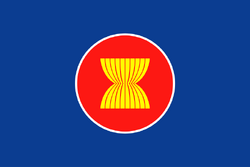| East Asian Association 东亚国家的协会 Asosiasi negara-negara Asia Timur สมาคมประชาชาติแห่งเอเชียตะวันออก | |

| |
 The location of the East Asia Association | |
| Capital | Singapore 6,607,143 inh |
| Largest City | Jakarta 29,003,598 inh - Great Java 175,078,000 inh |
| Official Language | All in the Union (english and chinese are the working languages) |
| Goverment Type - Prime Minister: |
Confederation -Yarwan Singerepok |
| Establishment -Reformation of Depok Tokyo Chart |
1967 - 2032 - 2069 |
| Area | 4,497,403 km2 |
| Population | 950,753,000 |
| GDP | ₡58 trillion |
| HDI | 0.953 |
| HDI Rank | 9th |
| Currency | Credit ₡ |
| Demonym | None. References are made toward nationality |
| Administrative Divisions | 10 Confederated states and 5 permanent attached members |
| Religions | 89% Atheism |
| Armed Forces | None. See UN Army |
The most culturally diverse of the socio-economic blocs, the East Asian Association, really only arose in its current form in 2032 out of fear of resurgent Chinese imperialism as China became the world’s leading superpower in the mid 2030s. However, although divided politically and culturally, economically the structure made sense and is now the third largest economy on Earth (but only if counted as a collective entity), just ahead of the European Union. A general sense of progressivism has further united the sovereign states, as has over a century of shared history.
The island nations are generally densely populated, with a high degree of automation and provolutionism present in their societies. This has somewhat isolated them from other states, but locally based corporations such as Samsung, Perusahaan Gas Negara and Hyundai/Kia continue to dominate global markets, whilst the Association as a whole leads in the fields of computing and robotics, only slightly tailing the USA and Europe in aerospace technologies – whilst the Oriental Orbital Elevators System contributes massively to the economy (particularly that of Indonesia and Malaysia) they have to share it with China. As with Europe, they tend to look towards space as a source of further expansion rather than squabbling with terrestrial neighbours and building massive armies to show off their power. Culturally and politically many of the member states have been influenced by the strict social hierarchy of Japan and are run as viciously competitive libertarian meritocracies under a direct democracy.
Political relations are generally distant as the Association, as aforementioned, is insular, however strong economic bonds are maintained both internally and externally with China, North America and the member states of the Indian Federation.
Member States[]
- Cambodia
- Indonesia
- Laos
- Malaysia
- Myanmar
- Philippines
- Singapore
- Thailand
- Vietnam
Attached Members[]
Unwilling to continue cooperating with the USA after WWIII and afraid that a powerful China alongside a resurgent Russia would cripple its interest and affect its domestic politics Japan got near the old ASEAN, in which it had big economic ties.
After its unification and during the polarization of the Pacific, the vulnerable Korea needed an strategic partner that allowed it to retain some independence in the Red, Yellow and Blue tides of the vast ocean.
Much of Australia has been reduced to desert, patrolled by largely automated mining rigs exploiting the country's rich reserves of mineral ores. Vast solar panel and solar updraft arrays scattered throughout this desert provide energy for the dense cities that cling to life around desalination plants along the eastern coast. The majority of the union's population instead occupies New Zealand, an island nation that, like the UK and Japan, remained relatively unscathed (rainfall has increased in all three regions) by climate change. The union of the two was more-or-less inevitable – the states have a long history of shared interests. They continue to occupy an odd position in world affairs, culturally Western (although increasingly influenced by huge population influxes from the island nations and the South-East Asian countries) but part of the Asian/Pacific region economy.